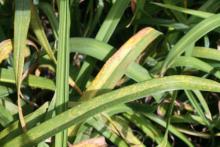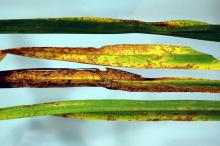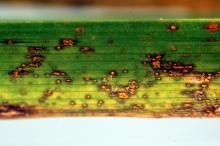Cause The fungus Puccinia hemerocallidis is an exotic rust native to Asia. This pathogen was detected in daylily (Hemerocallis spp.) nursery stock in the southeast in 2000. It has since spread to many other states and was detected at one site in Benton Co., Oregon in 2001. The infected plants were imported from a nursery in Florida. An eradication program was implemented at that site and none was found in 2002.
This rust can cycle on daylily alone or can use Patrinia as an aecial host in a heteroecious cycle. In Georgia, it was noted that the disease did not overwinter on plants that were killed to the ground. However, it may survive on evergreen cultivars or in regions with mild winters. Although infected nursery stock can spread the disease long distances, the spores of the fungus can be blown great distances. Spores germinate rapidly on wet leaves, can complete the infection process in as little as 5 hours once the leaf is wet at 72°F and can produce new uredinia in 1 to 2 weeks.
Many cultivars appear to be resistant to infection or produce few symptoms including Prairie Blue Eyes, Carolyn, Criswell, Mardi Gras Parade, Woodside Ruby, Hush Little Baby, Follow Your Heart, Chicago Apache, Buttered Popcorn, Green Flutter, Plum Perfect, Frankly Scarlet, Mama Cha Cha, Chinese Scholar and Charlie Pierce Memorial. Some cultivars noted to be highly susceptible include Stella D'Oro, Attribution, Pardon Me, Gertrude Condon, Crystal Tide, Starstruck, Imperial Guard, and Double Buttercup.
Symptoms Orange pustules (uredinia) erupt from leaf tissue of susceptible hosts. Lesions may be roughly angular, vein bounded and can appear on both leaf surfaces. Lesions vary from bright yellow to tan and water-soaked depending on the daylily cultivar. Leaves die quickly leading to large amounts of dead foliage. Resistant cultivars may produce only barely visible flecks.
Cultural control
- Cut, collect, and destroy infected leaves and the leaves from other daylilies in that bed.
- Collect and remove all leaf debris at season's end.
- Buy planting material from nurseries that have an inspection and control program in place.
- Keep new daylilies in isolation for observation before moving into your regular garden or production areas.
- Purchase resistant cultivars.
Chemical control Only if diagnosis has been confirmed. Few fungicides are labeled specifically for daylily, but these may be useful if not phytotoxic. Try on a few plants first before general application. None will result in complete control. Use on 2-week intervals. Longer intervals may not be effective.
- Banner MAXX at 5 to 8 fl oz/100 gal water. Rated with fair control. Group 3 fungicide. 12-hr reentry.
- Broadform at 4 to 8 fl oz/100 gal water. Group 7 + 11 fungicide. 12-hr reentry.
- Concert at 22 to 35 fl oz/100 gal water. May cause injury to buds, blooms or tender new growth. Landscape use only. Although registered it has not been very effective. Group 3 + M5 fungicide. 12-hr reentry.
- Compass 50 WDG at 2 to 4 oz/100 gal water. Do not use organosilicate additives. Group 11 fungicide. 12-hr reentry.
- Daconil Ultrex at 1.4 lb/100 gal water. Daylily not on the label but can be used if not phytotoxic. Rated as good control. 12-hr reentry.
- Eagle 20 EW at 6 to 12 fl oz/100 gal water. Has eradicant activity. Group 3 fungicide. 24-hr reentry.
- EcoSwing at 2.5 to 3.2 oz/10 gal water. Group BM01 fungicide. 4-hr reentry. O
- Heritage at 1 to 4 oz/100 gal water. Do not mix with silicone-based products. Good eradicant activity and excellent control. Group 11 fungicide. 4-hr reentry.
- Insignia SC at 3 to 6 fl oz/100 gal water. Do not use with organosilicate-based adjuvants. Group 11 fungicide. 12-hr reentry.
- Mural at 4 to 7 oz/100 gal water. Group 7 + 11 fungicide. 12-hr reentry.
- Myclobutanil 20 EW T&O at 6 to 12 fl oz/100 gal water plus spreading agent. May observe a PGR effect. Group 3 fungicide. 24-hr reentry.
- Orkestra at 6 to 8 fl oz/100 gal water. Group 7 + 11 fungicide. 12-hr reentry.
- Ortho Rose & Flower Disease Control at 2 fl oz/gal water. Group 3 fungicide. H
- Pageant at 6 to 12 oz/100 gal water. Do not use with organosilicone-based adjuvants. Group 7 + 11 fungicide. 12-hr reentry.
- Postiva at 10 to 28 fl oz/100 gal water. Group 3 + 7 fungicide. 12-hr reentry.
- ProStar 70 WG at 3 to 6 oz/100 gal water. Group 7 fungicide. 12-hr reentry.
- Torque at 4 to 10 fl oz/100 gal water. Good control. Group 3 fungicide. 12-hr reentry.
- Tourney EZ at 1 to 4 oz/100 gal water. Group 3 fungicide. 12-hr reentry.
Reference Emmitt, R.S., Stevenson, K.L., Brenneman, T.B., and Buck, J.W. 2016. Management of daylily rust with different fungicide combinations and spray intervals. Plant Disease 100:188-191.



